Diamond Certification – Why It’s a BIG Mistake to Shop With Only a Grading Report Blindly

If you are someone who is making a decision to buy or intending to place a deposit for a diamond based solely on a certificate, you are really asking for trouble shopping in this manner.
Likewise, if you are trying to look for help with an assessment or a 2nd opinion on the diamond and all you have is a GIA certification report number (with only a bunch of proportions/numbers), you will only end up wasting your time.
Now, if you fall into either category mentioned above, STOP whatever you are doing now and start reading every single word here. This article will reveal why you may be making a costly mistake and how you should approach buying an engagement ring the right way.
First of All, What is a Diamond Certificate?
A diamond certificate (aka grading report) is basically a document that lists gemological information about the diamond’s material properties and physical proportions. This document is prepared after an assessment is performed by a trained gemologist according to standards laid out by the grading lab.
As a consumer, you should only buy diamonds that are graded by GIA or AGS as they are the most accurate and consistent labs in the entire world.
If you buy a diamond graded by any other lab, I can guarantee you that the diamond is misrepresented and you’ll end up getting ripped off by unethical jewelers.
The Risks of Blind Faith in Diamond Certs And “Buying Off The Numbers”
While the diamond certificate is an essential document for shoppers, its usefulness is restricted to a gemological assessment of the diamond’s material properties. When it comes to determining the outward appearance of the diamond, the cert has severe limitations.
Let me illustrate this point by using 2 GIA graded round diamonds with comparable carat weight and SAME EXACT proportions. Both diamonds are selected based on ideal proportions and have the following numbers:
Table: 56.0%
Depth: 61.8%
Crown Angle :35.0°
Crown Height: 15.0%
Pavilion Angle: 40.8°
Pavilion Depth: 43.0%
Star Length: 50.0%
Lower Half: 75%

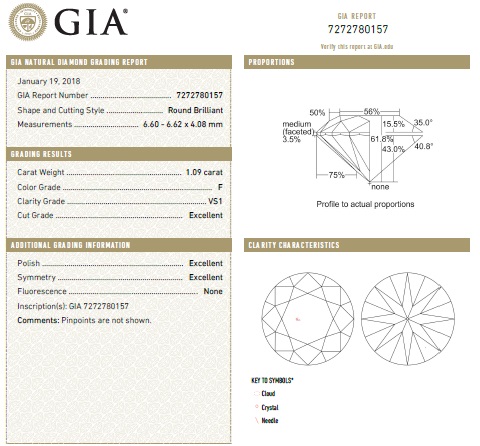
For your convenience, here are the direct links to the GIA reports: #1182952119 and #7272780157
When looking at these two GIA diamond certificates, most first time shoppers would assume that both diamonds will have similar light performance and appearances. After all, this is a logical conclusion since they are both cut to the same exact proportions.
Now, I know some people would argue that the F/VS1 diamond would be “more beautiful” because of its higher color rating. In a similar fashion, some others may even think that the H/IF diamond will be more brilliant and sparkly because of its internally flawless clarity rating.
What if I told you that all of these assumptions are wrong?
Let’s take a look at how the diamonds look like in real life and their corresponding scope images…

1.04ct H color IF clarity

1.09ct F color VS1 Clarity
In real life, both diamonds are visually different from each other.
Buying an engagement ring blindly is a trap that people fall into when they foolishly rely on the diamond certs. Granted, both diamonds still have decent brilliance and cut quality. But from the ASET and H&A images, I can tell you that they are not well cut enough for me to personally buy them.
In order to show you why tangible cut data is required for accurate assessments and why numbers don’t mean everything, I’ve listed another 2 GIA diamonds with the same EXACT proportions. That is to say, if you compare all 4 diamonds based on paper, they will appear to be identical to each other.


Here are the direct links to the GIA reports: #6183048279 and #7242451062
Despite all 4 diamonds being graded with GIA triple excellent grades (which is considered the best ratings obtainable from GIA), the truth is that these diamonds have significant variance. Just take a look…
Compared to the two previous stones, these 2 diamonds from James Allen have ideal light performance and better cut precision. And without the scope data, it would be impossible to distinguish between diamonds of average make and great make.
Never Buy a Fancy Shapes Without Magnified Videos or Photographs
All too often, I see consumers getting too caught up with finding the biggest diamond with the “best” specifications on paper and for the least amount of money. It’s absolutely foolish and risky to shop in this manner.
When it comes to fancy shape diamonds (e.g. cushion, oval, emerald, princess), relying solely on a diamond certification is simply a recipe for disaster. This is because the GIA grading reports for fancy shapes contain even LESS information about the diamond’s proportions.
If you think buying a round diamond blind is a bad idea, shopping for a fancy shape diamond based on values of table % and depth % is much worse! I want you to check out these GIA certificates that describe two cushion shape diamonds with a 60% table and a 68.4% depth…
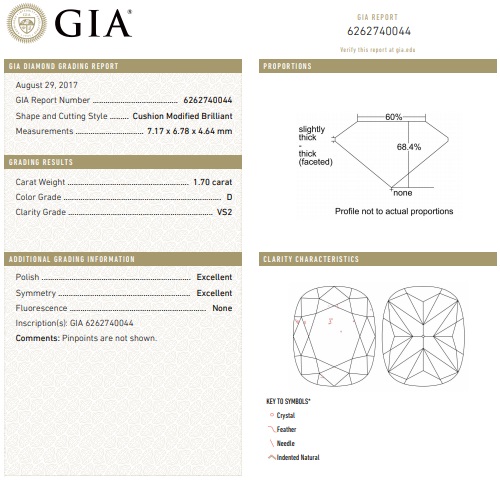
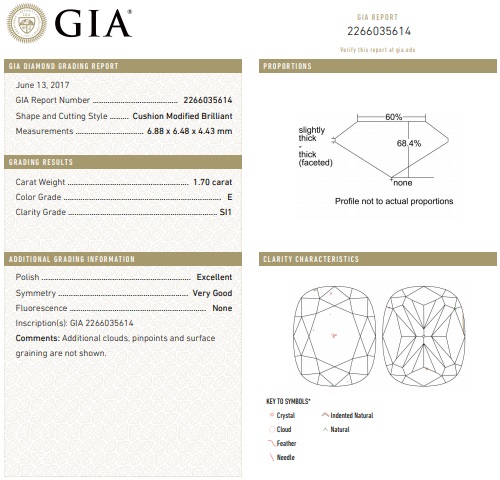
Here are the direct links to the GIA reports: #2266035614and #6262740044
Let me go on the record to say that nobody (including yours truly) would be able to offer any constructive advice based on the GIA certificates above.
Yet, it never ceases to amaze me how some people could “judge” and claim to make an educated purchase based on a grading report. Below, you can see how these 2 diamonds look distinctly different in real life despite looking similar on paper.
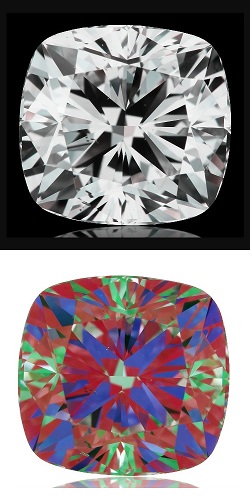
1.70ct D VS2 Cushion Cut
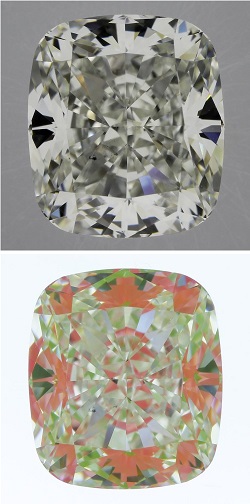
1.82ct H VS2 Cushion Cut
From the ASET scope images and videos, both diamonds have completely different light performances and scintillation patterns. The one on the left has strong light return while the other is a diamond with significant light leakage (will look mushy).
If you had to buy either diamonds without tangible data, how would you know which stone to pick? Do you want to leave the outcome of such an important purchase to chance?
And just to be clear: well cut diamonds like the one on the left are rare. We are definitely not talking about a 50/50 probability to make the right selection. The fact is, the majority of cushion shape diamonds in the market are not cut to good optical standards.
At any one time, there could easily be tens to hundreds of diamonds that look “the same” on paper. What makes you think you would strike the lottery in picking the single best diamond out of all the available stones?
What About Clarity? Is it Possible to Tell If a Diamond is Eyeclean?
When gemological laboratories grade diamonds, they will assess the type of inclusions found in the diamond and list them in the grading certificate. Typically, a plot of the diamond’s clarity characteristics would be provided for stones above 1ct in size.
At this point, I want to set things straight and hammer in an important point. The grading report is only useful in identifying gemological properties of the diamond. It does not portray how the diamond looks like in real life.

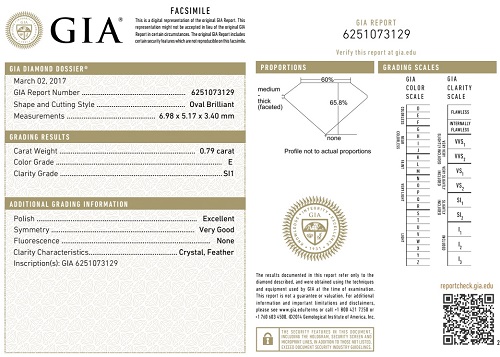
Here are the direct links to the GIA reports: #1265664441 and #6251073129
With or without the clarity plot, there’s no way you can determine eyecleanliness based on a certificate if you are shopping for a diamond in the VS or SI clarity range. To do this, you NEED magnified videos or images.
Let me show you how the corresponding diamonds above look like in real life. I want you to click on the followings images and interact with the magnified videos for yourself.
With the videos, can you easily tell which diamond is eyeclean and which isn’t? Could you imagine the scenario where you blindly purchased the 0.79ct E SI1 diamond and received an engagement ring with dark visible inclusions?
The moral of the story is: if you don’t want any nasty surprises, you shouldn’t be making a purchase decision by relying on the diamond certificate alone.
Certificates Won’t Reveal Shape Appeal of Fancy Cut Diamonds
Since we are on the topic of fancy cut diamonds, shape appeal is another important characteristic that impacts beauty. If you were buying based on a piece of grading certificate, there’s no way you know how the outline of the stone would look like.
Check out these three other oval diamonds with the same proportions as the stones above and you will see what I mean.
The first oval on the left has good shape appeal. The second stone in the middle is awkwardly shaped like an elongated bean. The third has a squatty outline and squared shoulders that looks horrible. By now, I hope you can see the recurring theme of how shopping based solely on a diamond certificate is such a big mistake.
Summary – The Diamond Certificate by Itself is Insufficient!

The bottom line is, making an educated buying decision based solely on a grading report isn’t possible.
If reading this article and seeing these examples doesn’t change the way you shop for diamonds, all I can say is that you deserve to pay the price for having a stubborn mindset.
Why would you want to buy blind or limit yourself to a mediocre vendor that is unable to provide you with hard, tangible data? Doing so would be akin to rolling the dice and hoping you get a lucky outcome.
In today’s market, online vendors like James Allen and Blue Nile have revolutionized the industry with the use of interactive video technology. This makes the shopping process fully transparent and far easier compared to buying in a physical store.
Besides giving consumers the ability to scrutinize diamonds with magnified videos, online retailers like White Flash and Brian Gavin also provide indepth performance data like Idealscope and ASET images.
I strongly encourage you to check out these vendors and see the difference in the shopping experience for yourself. Have fun shopping!
Related Articles
Leave A Comment

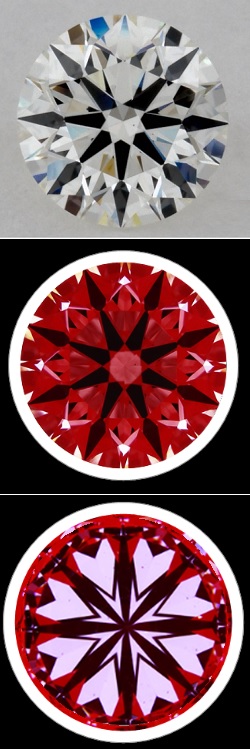

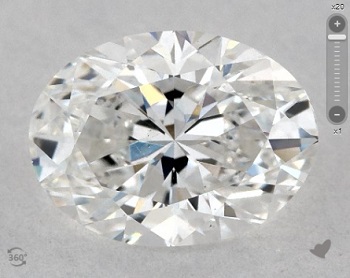
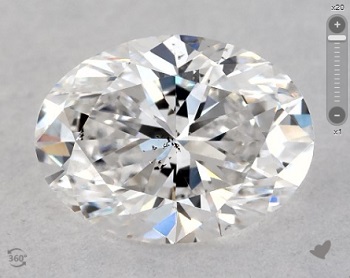
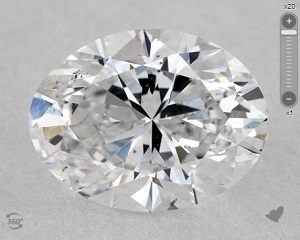
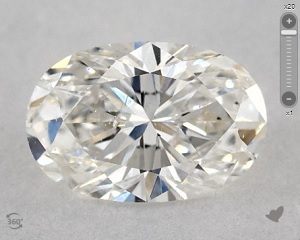
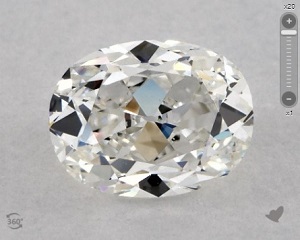

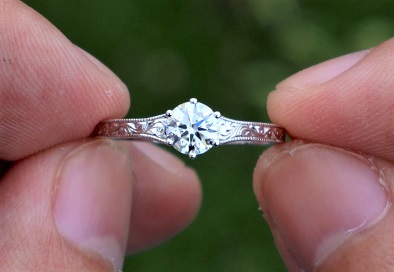











8 Comments
My jeweler has quoted me $5,500 for a diamond ring with a certificate from an independent gemological laboratory called AGGL. He says that a GIA diamond certification is unnecessary as it costs more and makes the diamond more expensive.
If we are buying a diamond, why do we need to care about what a piece of document?
After all, I am buying the diamond and not the paper. The certed diamonds he showed me were all 20-30% lower in price compared to those that had GIA diamond certs.
First of all, I can tell you that this seller isn’t being honest and is attempting to profit off your ignorance. In fact, I will even say he is a scumbag. The reason why the “certed diamonds” sold by this person is cheaper is because they are inaccurately represented.
While it is true that the GIA diamond certification may not provide all the answers to making a shopping for an engagement ring, what it does actually protects you as a consumer. The GIA cert is an unbiased opinion of the diamond’s material properties.
That is to say, when GIA says the diamond is a G color, SI1 clarity, the diamond is exactly that. I can tell you with a fair degree of certainty that the AGGL report will be grossly off the scales. If it states the diamond to be G color, SI1 clarity, you can expect the diamond to be a I/J color with I1 levels of clarity.
I’ve just came back from a visit to a local dealer who told me that AGS is not a reputable lab and the best diamond certification is from GIA. Also, he did explicitly mentioned that buying a diamond online is dangerous as the low quality stones are pedaled online while the better ones are sold in store.
Saying AGS is not a reliable lab just shows how much ignorance the jeweler has of the industry. Both GIA and AGS are the best diamond certification labs and leading authorities when it comes to research too. That is to say, if a diamond is graded as I color by GIA, it is going to be graded as an I color by AGS. Here’s the thing, since humans are involved, there is always an allowable variance of +-1 grade. But I find them to be consistent 99% of the time.
Contrary to what you think, you are shopping for an engagement ring blind or making decisions based on a grading certificate. With the better online vendors, the interactive videos, tangible data provided and sales policies will beat whatever offerings you can find in your local store.
All you need to do to see who is bull shitting you and who isn’t is to review the hard data when making comparisons. Physical vendors usually diss the Internet vendors because of conflicts of interest.
And why should I believe what you say?
Well, because I am right! As I said, all you need is the proper data to make comparisons and do some research. Ultimately, you will come to the conclusion that I’m right.
As a consumer myself, I know that buying a diamond can be an intimidating process. You can do yourself a favor and not make things even harder by shopping with a reliable vendor.
Good’day mate!
What’s the best diamond certification in Australia? You mentioned GIA and AGS but I was told by my local jeweler that the best diamond cert is from GIA and they had never heard of AGS before.
Strictly speaking, a diamond certificate is an inaccurate terminology for a grading report. This is because the gemological labs that perform the grading do not certify anything. The reason why the use of “certification” is so prevalent is because jewelers and consumers use the terms interchangeably.
Now, AGS (American Gem Society) is not as well received as GIA in some parts of the world due to marketing purposes. However, let me tell you that both laboratories are reliable. In fact, AGS is much stricter than GIA as they utilize ray tracing to measure a diamond’s light performance. GIA, on the other hand, utilize an approach that isn’t as scientific as they base their cut grading on measured proportions and a visual inspection by a human being.